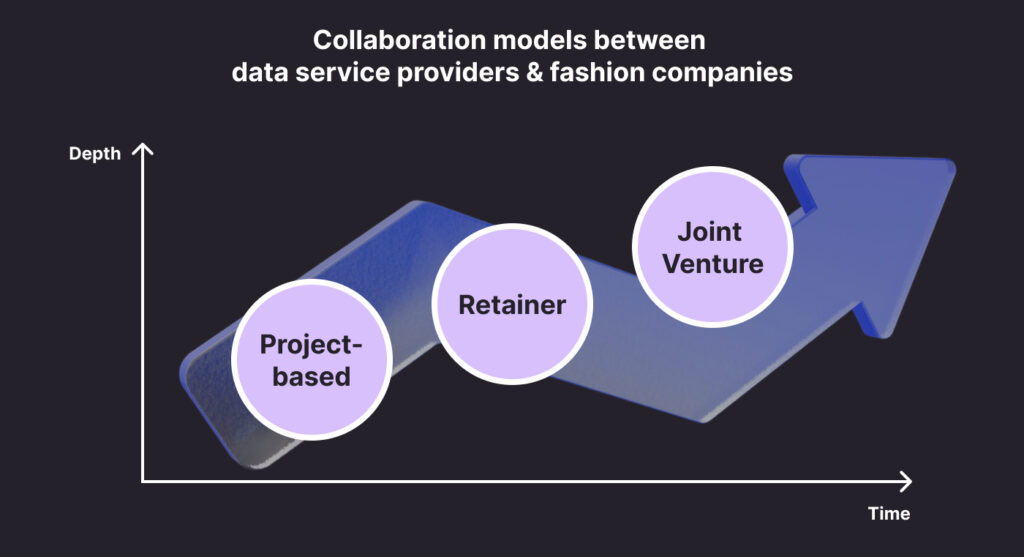As the digital transformation progresses, the ability to use data strategically has become a decisive competitive factor across industries. However, many fashion companies still face significant barriers when it comes to managing and using their data strategically to gain value from it. This is where external partners come into play. In this article, we shed some light on the fashion industry and its digital transformation, and how it can build productive collaborations with data service providers to stay ahead of the highly competitive market.
If you’re not familiar with the fashion industry, I’d recommend reading this brief introduction first:
Introduction: What You Need to Know About the Fashion Industry
The fashion industry is a key player in the global economy, facing constant pressure from market shifts and economic uncertainty. It’s a sector that, while historically rooted in craftsmanship and tradition, has always evolved in response to technological and societal changes. As one of the oldest and most dynamic industries, fashion is currently empowered but also challenged by the emergence of big data and digital innovation. Additionally, it’s a highly competitive market environment, consisting of numerous firms offering similar products. Also typical for the whole industry is the widespread segmentation of products, which remain highly volatile due to the regular changes of seasons and trends.
Over recent decades, globalization and shifting consumer expectations have significantly transformed the structure and demands of the fashion market. Companies, therefore, must navigate highly complex supply chains, adapt rapidly to volatile trends, and meet growing expectations for personalisation and sustainability.
A fashion company typically has a complex structure that combines very different jobs, from highly creative to managerial and analytical roles. Because of this organisational complexity, it’s hard to analyse the fashion industry as one industry – still, in this article, we at least attempt to.
Digital Transformation in Fashion
Digital transformation, in general, is the strategic integration of digital technologies and cultural change into all business areas. The overarching objectives of digital transformation are boosting efficiency, adaptability, and profitability. Digital and data-driven transformations are crucial across many industries, but especially in customer-centric sectors such as the fashion industry.
In fashion, digital transformation goes beyond customer-facing solutions and increasingly includes innovations across the entire value chain. Examples include real-time supply chain visibility, demand planning, cloud-based manufacturing, and dynamic inventory optimisation. These technologies enable faster responses to market fluctuations and support more sustainable, trackable production processes. In parallel, digital communication tools, smart devices, and e-commerce platforms continue to gain relevance, reinforcing the shift toward a data-centric, connected fashion ecosystem. This ecosystem can be illustrated with the example of Inditex (Zara): a company-owned data centre operates 24/7 to process information related to supply chains, sales, energy consumption, and more, to manage all business areas in a data-driven way and use resources as efficiently as possible.
The use of advanced technologies in the fashion industry
Moreover, the industry is progressively leveraging advanced technologies such as artificial intelligence (AI) and machine learning. In the fashion context, AI can support forecasting, trend analysis, fashion design, and much more. Machine learning can support product development and complex demand prediction, for example. These technologies are complemented by innovations such as 3D and 4D scanning systems, recording digital body data in motion to extract anthropometric parameters, which consist of the human body’s measurements and proportions. This enables fashion companies to optimise fit and functionality in garment design, based on precise digital representations of the human body.
Big data analytics (BDA)
Another technology is big data analytics (BDA), which enables the customisation of offers based on individual consumer profiles and purchase history. A key prerequisite for such transformations is the identification and digitalisation of master data. Master data includes both structured and unstructured datasets from sources like 3D body scans, material platforms, CRM tools, or digital printing processes across the end-to-end value chain. In line with this development, many companies have adopted virtual customer fitting and design-support systems on e-commerce platforms in response to the rapid growth of big data and online retail. If you want to read a bit more about the role of data in fashion, start with my previous article: Fashion’s Data Dilemma: Strategic Management or Cluelessness?
Collaboration with Digital Service Providers
For fashion companies looking to bring data-driven techniques into their day-to-day operations, digital service providers are becoming go-to partners for building and executing effective data strategies. In industries like finance and tech, these partnerships have already proven their value. In the fashion sector, however, such collaborations remain relatively uncommon, and those that exist are often limited to isolated, project-based initiatives. They may help a company achieve a specific goal but rarely lead to deeper integration into its data infrastructure or management processes.
Yet, as the push toward data-driven transformation gains momentum, these collaborations are becoming increasingly relevant. External providers don’t just bring technical know-how. They also bring a fresh, entrepreneurial perspective, something that’s often hard to foster in traditional fashion companies weighed down by rigid processes, a fear of risk, or limited resources. So, what can these collaborations actually look like in practice?
What Concrete Cases of Data Partnerships Exist?
Rent the Runway x Oracle
One example is the case of US-based fashion rental platform Rent the Runway, which partnered with Oracle, a global leader in cloud infrastructure, software, and data solutions, in what is essentially a strategic technology collaboration. By bringing in a chief scientist from Oracle, the company gained advanced analytics expertise to refine its already data-heavy operations. This partnership allowed Rent the Runway to use sophisticated algorithms at every step of the rental journey, from outfit recommendations to inventory logistics, based on rich behavioural data such as reviews, location, and wear frequency. As a result, the platform could offer highly personalised customer experiences while optimising stock and reducing waste.
Speaking of behavioral data…you might want to read my colleague’s technical deep-dive article on how a behavioral data model works to get a sense of its full potential for leveraging website user data.
Elle Zeitoune x Heuritech
In a project-based data partnership, Australian designer brand Elle Zeitoune teamed up with the fashion tech company Heuritech. Elle Tabet, the designer and founder of Elle Zeitoune, wanted to integrate data-driven insights into her design process to ensure that her creations were not only innovative but also aligned with current market preferences. To support this, Heuritech developed a market insights platform capable of analysing millions of social media images using computer vision technology. Their system detected and tracked over 20,000 trends across elements such as colours, prints, shapes, fabrics, and details. The data was then segmented into 15 global regions, four age groups, and three audience types (edgy, trendy, and mainstream). Heuritech aimed to predict trend demand up to 24 months in advance, delivering predictive insights on colours, prints, and fabrics. For Elle Zeitoune, this meant being able to plan four seasonal collections with data-backed design choices, while still maintaining creative control. The collaboration gave the brand a fast and accurate way to align its designs with market demand, boosting both relevance and sustainability.
Hugo Boss x Metyis
HUGO BOSS entered into a long-term strategic partnership with Metyis, culminating in the opening of the HUGO BOSS Digital Campus in Portugal in 2023. The goal: to strengthen data analytics, build a better data architecture, and accelerate digital sales growth. With Metyis’ expertise in advanced business analytics and AI, the fashion brand could scale its e-commerce capabilities and integrate data-driven decision-making across its operations. The Digital Campus can be considered as a kind of joint venture. In this case, Metyis, as a technology and data partner, works directly with HUGO BOSS to leverage all available company data.
What Collaboration Models Exist?

Collaboration between data service providers and fashion companies can take various forms:
…Project-based, to achieve one specific goal together. For example, implementing data-driven trend forecasting for the upcoming season.
…Long-term collaboration in the form of a retainer. For instance, to improve a fashion company’s data management, including running regular workshops, working toward clearly defined goals, all for a fixed monthly fee.
…As a joint venture,a long-term partnership where two companies combine their expertise and resources to pursue shared objectives.
Where Does the Value Lie in Such Collaborations?
There are several areas where fashion companies can evolve, and where external support from a data-native company can make a significant difference. Examples include:
- Improving website search functionality, for instance, by increasing the accuracy of search results.
- Optimising demand forecasting to better plan logistics, especially for major campaigns or promotions like Black Friday, where sudden spikes in order volumes play a major role in the annual revenue of large fashion companies.
- Enabling trendsetting or trend-following strategies, which require both rapid data collection and real-time analysis to respond effectively to market signals.
- Capturing data generated by a company’s own activities quickly, which adds another layer of complexity in managing high data volume and speed.
- Implementing advanced technologies, such as AI features on a website. These tools are highly data-driven and can only deliver meaningful results if the necessary foundations, such as data access, quality, and processes, are already in place.
Therefore, external data service providers bring a fresh, unbiased perspective along with the skills and experience companies often lack internally. Often, they’re able to cover everything end-to-end, from strategy and technical data engineering to advanced AI applications. They help build data catalogues and architectures, laying the groundwork so advanced technologies can reach their full potential. They also assess data management maturity, clarify the overall data landscape, and improve areas like data governance.
On top of that, they show employees that they’re already working with data every day and teach them how to use it effectively without fear – whether that’s fear of responsibility or the need for extra training. Providers can support big-picture concepts like Data Mesh to turn siloed data into accessible, actionable knowledge, while helping internal teams gradually take ownership of their data processes. And, of course, they can build dashboards that track KPIs, analyse performance, or spot trends, for example, with the use of our CLV model.
A Noteworthy Basis for Collaboration: The Digital Product Passports (DPPs)
One potential area for collaboration could be establishing strong traceability, allowing clothing data to be accessed by consumers, all under the broader topic of sustainability. A practical example is digital product passports, or DPPs for short. These are becoming a key method for increasing transparency, enabling every step of the supply chain to be tracked and made visible through scannable digital formats. By 2030, the use of DPPs will be mandatory for all garments sold within the European Union, and tech analysts at ABI Research predict that more than 62.5 billion DPPs for clothing will be created by then, requiring large-scale data collection and exchange. QR codes embedded in clothing labels, for instance, can allow customers to access detailed information about a garment’s origin, its environmental impact (such as carbon and water footprint), and care instructions, including repair guidance.
DPPs as an opportunity to improve the data strategy
Since DPPs are going to be mandatory anyway, they should be seen as a strategic opportunity for collaboration: automating how manufacturing data is gathered and shared through product labels enables full transparency across the entire lifecycle and allows brands to communicate accurate, fact-based information to consumers. This approach also reduces the need for time-consuming manual data collection or the complicated integration of various Excel files and software systems. To make DPPs a reality, companies can work together to establish or modernise the necessary systems, creating a shared foundation for transparency and sustainable collaboration.
Diconium and Its Role as a Data Service Provider
Diconium has already supported clients across a wide range of sectors in their broader digital transformation initiatives. For brands aiming to professionalize their data usage and modernize their digital infrastructure, Diconium has, over many years, delivered considerable added value, laying the groundwork for effective data management and implementing innovative technologies such as Smart Search, our AI-powered product search.

